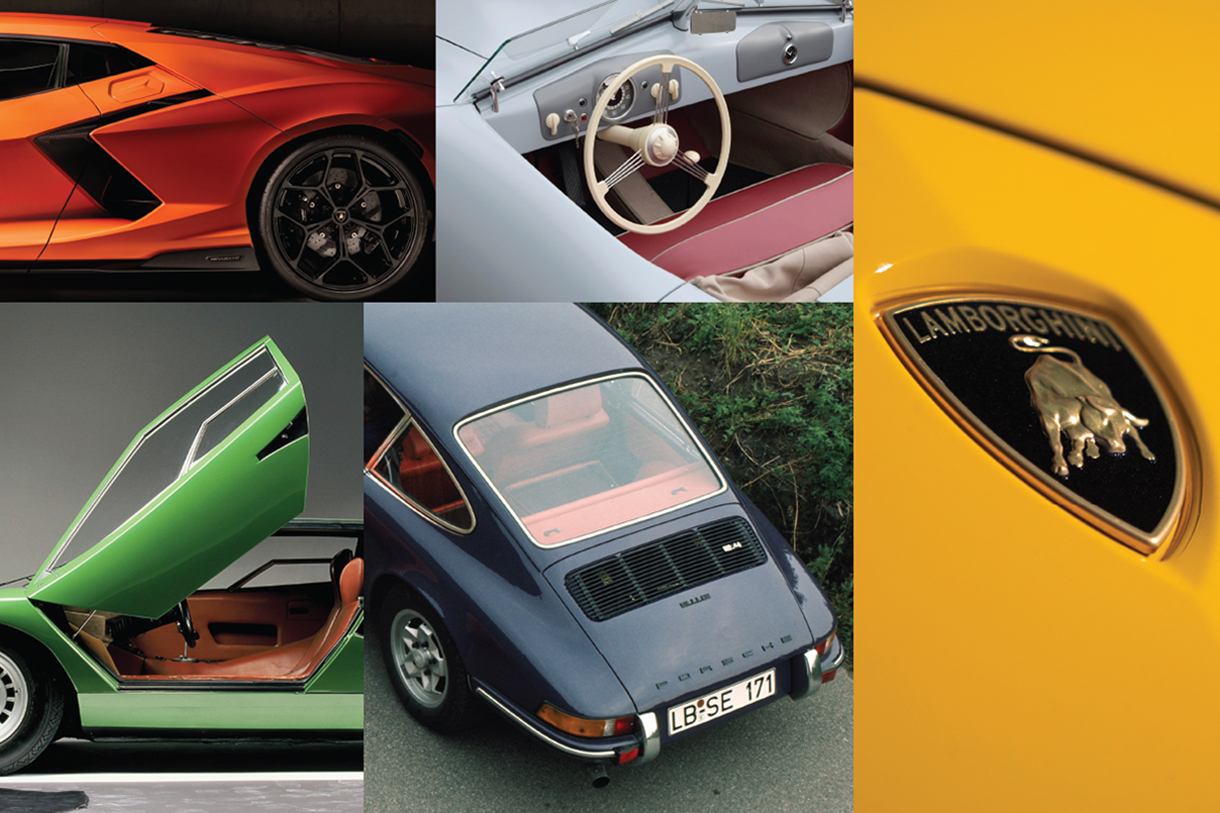
Lamborghini Revuelto 2023, Porsche 356, 1948 Lamborghini Urus SUV 2018, Porsche 911 E 2.4 1972–1973, Lamborghini Countach 1974 (clockwise left to right)
Vehicles
Legendary Automotive Brands Guide Drivers into Electric Age
by Brett Berk
The gas-powered automobile has been around for nearly 140 years, and many of the most venerable names in the industry—Mercedes-Benz, Aston Martin, Cadillac, Rolls-Royce, Bentley—have been producing luxurious vehicles for over a century. Longevity is relevant, as cars are an extremely labor- and cost-intensive product; a new model can require six years and a billion dollars in investment.
Today’s test of the times for carmakers is the auto industry’s shift to electric vehicles (EVs)—expected to make up 40 percent of American new vehicle sales by the end of the decade. Start-ups like Tesla, Lucid, and Rivian bring fresh products and perspectives to the category, while heritage automakers are rolling out an onslaught of battery-powered vehicles, attempting to reassert their dominance. Their august reputations offer mainstream consumers brand familiarity and confidence as they prepare for this profound change.
For two marques celebrating significant anniversaries—60 years for Lamborghini and 75 for Porsche—we take an in-depth look at the storied brands, both their origins and their futures.
Today’s test of the times for carmakers is the auto industry’s shift to electric vehicles (EVs)—expected to make up 40 percent of American new vehicle sales by the end of the decade. Start-ups like Tesla, Lucid, and Rivian bring fresh products and perspectives to the category, while heritage automakers are rolling out an onslaught of battery-powered vehicles, attempting to reassert their dominance. Their august reputations offer mainstream consumers brand familiarity and confidence as they prepare for this profound change.
For two marques celebrating significant anniversaries—60 years for Lamborghini and 75 for Porsche—we take an in-depth look at the storied brands, both their origins and their futures.
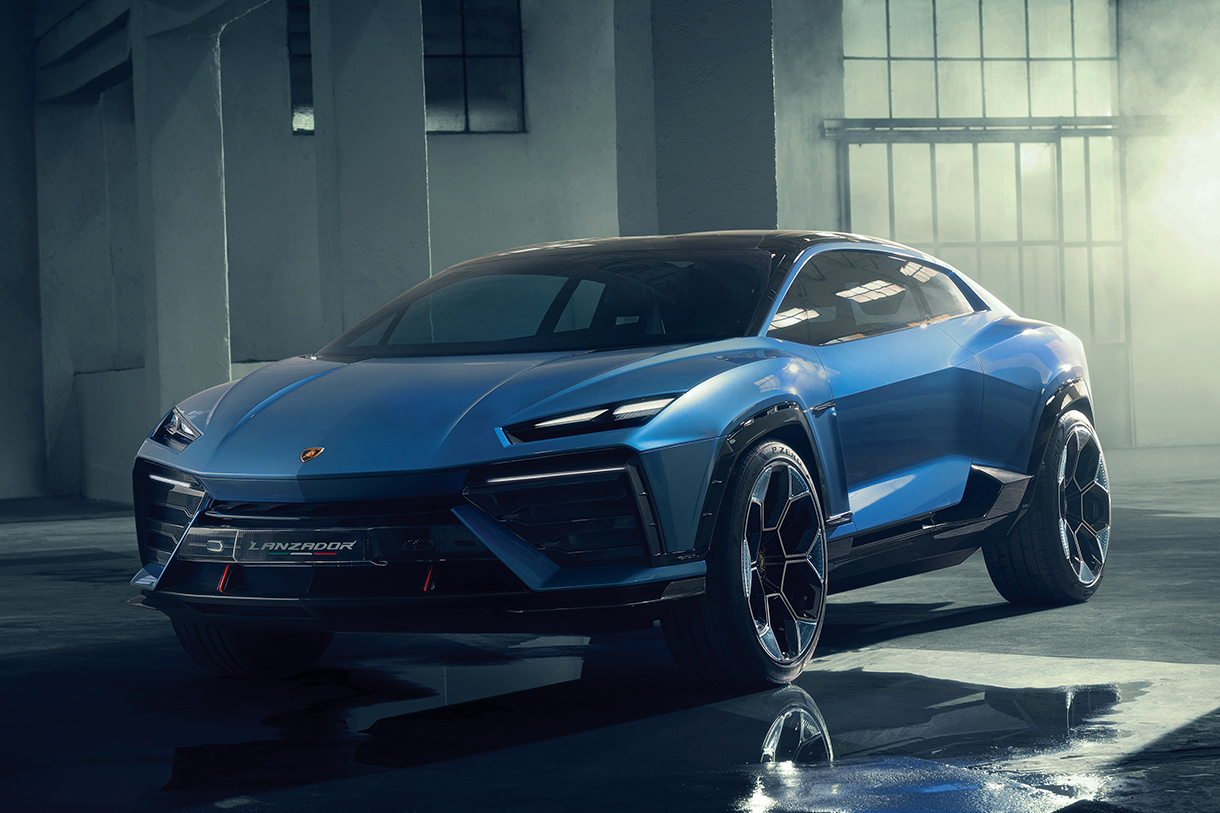
Lamborghini Lanzador 2028
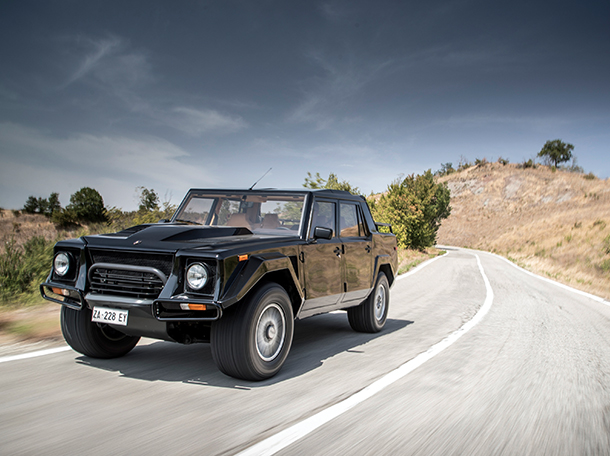
Lamborghini LM002 1986
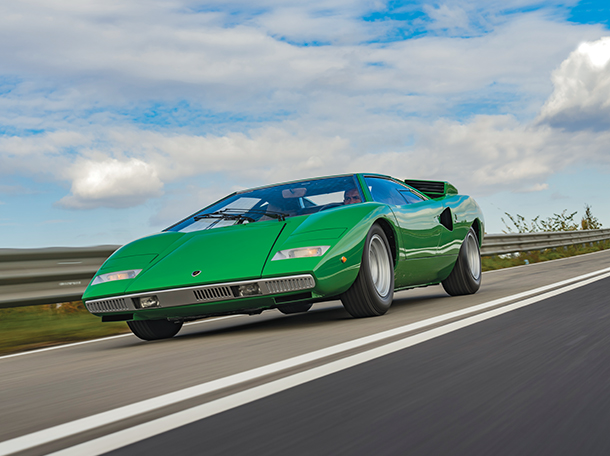
Lamborghini Countach 1974
Lamborghini
Founded in 1963 as a challenger brand, Lamborghini took direct aim at Italy’s most revered sporting marque. “Ferruccio Lamborghini wanted to do something better than the leader of the market, which was Ferrari,” says Federico Foschini, Lamborghini’s chief marketing officer.Ferruccio, having founded a profitable tractor company during Italy’s post-WWII economic boom, was, like other successful businessmen, seeking out symbols to showboat his new wealth—and bought a Ferrari. But he found himself dissatisfied. “He was a customer, and he was not happy. He was not treated in a fair way, in his opinion, by Ferrari. So, he decided to build this car on his own,” says Foschini. “He was a visionary, a man that wanted to fulfill his dream by being the producer of the car he was dreaming of.”
This unique positioning gave Lamborghini a certain drive, to create products that created or defined fresh categories. “I think that our heritage is giving us this kind of attitude of looking forward to challenge the status quo, to be unexpected, and to create something that at the moment of the launch is something that is beyond any other product,” Foschini says.
The Miura of 1966 was thus the first-ever “supercar” (the term was reportedly invented by a British car journalist to describe the model), featuring a sensually curvaceous body and outrageous acceleration from a roaring V12 engine mounted sideways behind the passenger compartment. The Countach of 1974 defined the sharply creased, doorstop-shaped “wedge” aesthetic, as well as the maximalist addition of strakes, vents, wings, and scoops that dominated supercar design for decades after. The LM002 of 1986 was the first super-SUV, a leather-lined four-door, all-wheel-drive vehicle with an explosively potent motor, presciently forecasting the luxury sport ute craze of our contemporary era—one capitalized upon by Lamborghini itself with its Urus SUV of 2018, which has singlehandedly doubled the brand’s annual production.
The limited-edition Sian of 2019 was the marque’s first production hybrid. Just this year, it unveiled its first electrified production supercar, the Revuelto, which is also the world’s first V12-engined, plug-in hybrid High-Performance Electrified Vehicle (HPEV). This will be followed by Lambo’s first fully electric vehicle, a four-seat Gran Turismo called the Lanzador, slated for 2028.
Like most other manufacturers in the ultra-sport/luxury category, a fuller range of electric vehicles will follow. “Everybody at Lamborghini is looking at the future,” Foschini says. “Already today, our customer base is very young, 40–45 years old on average, which is very low for our category. But the fan base is even younger, because now, for the kids, Lamborghini is the brand to be because it’s so futuristic, so extravagant, that they find it is very similar to what they’re doing daily on their iPads and gaming consoles.”

Porsche 944 Turbo 1985
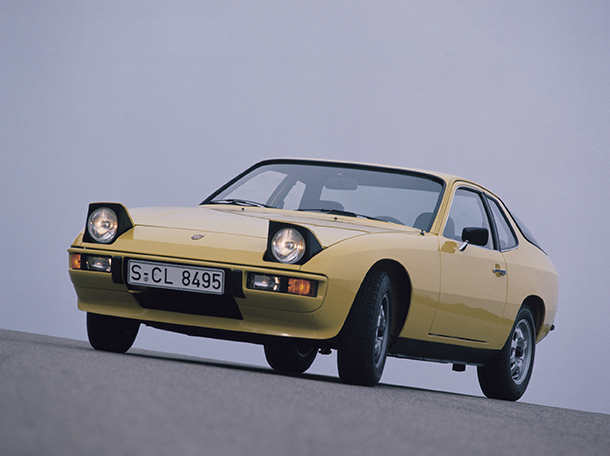
Porsche 924 Turbo 1981
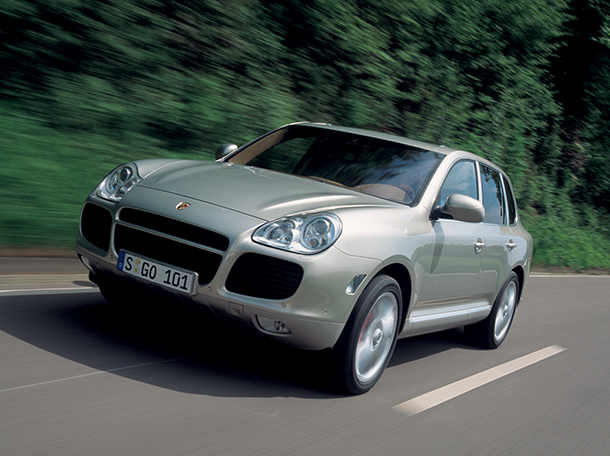
Porsche Cayenne 2002
Porsche
As well-known as the 75-year-old German sports car manufacturer is for crafting engaging, unique, novel, and precise vehicles—like the famed 911, which is itself celebrating 60 years in production—it’s less known that founder Dr. Ferdinand Porsche was a widely respected automobile designer well before launching his own company.This includes his early efforts at building hybrid gasoline/electric vehicles at the start of the 1900s, and consultations on cars from other notable Teutonic brands in the decades after, including work for Mercedes and Audi. It also includes his participation with the WWII-era German government on race cars and military vehicles, and on the first Volkswagens, an attempt to provide affordable transportation for the German populace.
“We are proud of our heritage. It is the foundation for a successful future,” says Oliver Blume, chairman of Porsche’s executive board. “We associate our heritage with innovation and progress, and continually add extraordinary new moments to the unique Porsche story.”
Porsche’s first production vehicle, the two-door 356 sports car, was based on a souped-up version of the VW Beetle’s atypical rear-engine design. Available for 17 years beginning in 1948, the model was imported into the United States, ultimately helping expose Americans to the joys of racy European vehicles.
To follow this long and influential run, Dr. Porsche’s son, Ferry, designed a successor, aiming to create a spirited sports coupe that could still act as a practical family car. To this end, the rear-engine 911 sported a big front trunk and a pair of child-sized rear seats.
Vintage 911s remain among the most desirable vehicles in the collector car universe, appealing to as broad a range of demographics (and bank accounts) as the model offered during its run, from bare bones to luxury, basic to track-prepped. The 911 constantly innovated to maintain its pinnacle prominence, being among the first sports cars to experiment with removable targa roof panels, front and rear aerodynamic spoilers, turbocharging, and four-wheel drive.
In the 1970s and ’80s, Porsche attempted producing more affordable vehicles, like the diminutive, rectangular, mid-engine 914 and the sharp, swoopy front-engine 924 and 944 sports coupes. This yielded derision from brand loyalists, who saw apostasy in any deviation from the rear-engine 356/911 formula. But the greatest ridicule was reserved for the egg-shaped, V8-powered 928 of 1977, a big, luxurious coupe that was intended as a replacement for the 911. (Internal corporate maneuvers prevented that from occurring.)
A similar sense of betrayal mounted when the brand released its first SUV, the Cayenne, in 2002. But its growing fleet of SUVs are so good, so Porsche-like, and so popular (they currently represent 60 percent of the brand’s global sales) that even Porschephiles have embraced them. Likewise with the Taycan, the brand’s first fully electric vehicle, a slightly insectiod four-door sedan or five-door wagon.
As the marque moves further into its electric future with a forthcoming battery-powered Macan compact SUV and a two-seat coupe and convertible, as well as a hybrid 911, it’s certain that all Porsches will retain the brand’s precise, compelling, and aspirational magic. “Seventy-five years of Porsche stand for pioneering spirit, passion, and dreams,” says Blume. “We are celebrating together with people who are inspired by dreams.”




